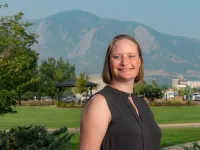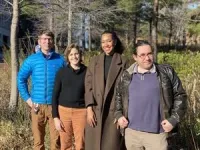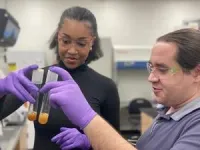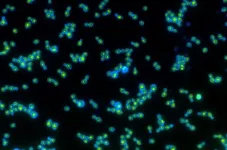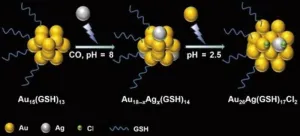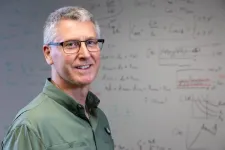(Press-News.org) Hop in the car to meet your lover for dinner and a flood of dopamine— the same hormone underlying cravings for sugar, nicotine and cocaine — likely infuses your brain’s reward center, motivating you to brave the traffic to keep that unique bond alive. But if that dinner is with a mere work acquaintance, that flood might look more like a trickle, suggests new research by University of Colorado Boulder neuroscientists.
“What we have found, essentially, is a biological signature of desire that helps us explain why we want to be with some people more than other people,” said senior author Zoe Donaldson, associate professor of behavioral neuroscience at CU Boulder.
The study, published Jan. 12 in the journal Current Biology, centers around prairie voles, which have the distinction of being among the 3% to 5% of mammals that form monogamous pair bonds.
Like humans, these fuzzy, wide-eyed rodents tend to couple up long-term, share a home, raise offspring together, and experience something akin to grief when they lose their partner.
By studying them, Donaldson seeks to gain new insight into what goes on inside the human brain to make intimate relationships possible and how we get over it, neurochemically speaking, when those bonds are severed.
The new study gets at both questions, showing for the first time that the neurotransmitter dopamine plays a critical role in keeping love alive.
“As humans, our entire social world is basically defined by different degrees of selective desire to interact with different people, whether it’s your romantic partner or your close friends,” said Donaldson. “This research suggests that certain people leave a unique chemical imprint on our brain that drives us to maintain these bonds over time.”
How love lights up the brain
For the study, Donaldson and her colleagues used state-of-the art neuroimaging technology to measure, in real time, what happens in the brain as a vole tries to get to its partner. In one scenario, the vole had to press a lever to open a door to the room where her partner was. In another, she had to climb over a fence for that reunion.
Meanwhile a tiny fiber-optic sensor tracked activity, millisecond by millisecond, in the animal’s nucleus accumbens, a brain region responsible for motivating humans to seek rewarding things, from water and food to drugs of abuse. (Human neuroimaging studies have shown it is the nucleus accumbens that lights up when we hold our partner’s hand).
Each time the sensor detects a spurt of dopamine, it “lights up like a glow stick,” explained first-author Anne Pierce, who worked on the study as a graduate student in Donaldson’s lab. When the voles pushed the lever or climbed over the wall to see their life partner, the fiber “lit up like a rave,” she said. And the party continued as they snuggled and sniffed one another.
In contrast, when a random vole is on the other side of that door or wall, the glow stick dims.
“This suggests that not only is dopamine really important for motivating us to seek out our partner, but there’s actually more dopamine coursing through our reward center when we are with our partner than when we are with a stranger,” said Pierce.
Hope for the heartbroken
In another experiment, the vole couple was kept apart for four weeks—an eternity in the life of a rodent — and long enough for voles in the wild to find another partner.
When reunited, they remembered one another, but their signature dopamine surge had almost vanished. In essence, that fingerprint of desire was gone. As far as their brains were concerned, their former partner was indistinguishable from any other vole.
“We think of this as sort of a reset within the brain that allows the animal to now go on and potentially form a new bond,” Donaldson said.
This could be good news for humans who have undergone a painful break-up, or even lost a spouse, suggesting that the brain has an inherent mechanism to protect us from endless unrequited love.
The authors stress that more research is necessary to determine how well results in voles translate to their bigger-brained, two-legged counterparts. But they believe their work could ultimately have important implications for people who either have trouble forming close relationships or those who struggle to get over loss – a condition known as Prolonged Grief Disorder.
“The hope is that by understanding what healthy bonds look like within the brain, we can begin to identify new therapies to help the many people with mental illnesses that affect their social world,” said Donaldson.
END
Neuroscientists identify 'chemical imprint of desire'
Study shows dopamine is critical for keeping love alive
2024-01-12
ELSE PRESS RELEASES FROM THIS DATE:
Trends in cancer mortality disparities between Black and white individuals in the US
2024-01-12
About The Study: Although U.S. age-adjusted cancer mortality rates declined significantly between 2000 and 2020, substantial racial and ethnic disparities persisted for many common and preventable cancers, including female breast and male colorectal cancer. Cancer disparities arise from a confluence of factors, including structural racism, medical mistrust, health care access inequities, poor socioenvironmental conditions, aggressive tumor biology, and genetic ancestry.
Authors: Tomi Akinyemiju, Ph.D., M.S., of the Duke University School of Medicine in Durham, North Carolina, is the corresponding author.
To access the embargoed study: Visit our For The Media website ...
Medicaid expansion under the Affordable Care Act and early mortality following lung cancer surgery
2024-01-12
About The Study: In this study of nearly 15,000 adults with non–small cell lung cancer, Medicaid expansion was associated with declines in 30- and 90-day postoperative mortality following hospital discharge. These findings suggest that Medicaid expansion may be an effective strategy for improving access to care and cancer outcomes in this population.
Authors: Leticia M. Nogueira, Ph.D., M.P.H., of the American Cancer Society in Atlanta, is the corresponding author.
To access the embargoed study: Visit our For The Media website at this link https://media.jamanetwork.com/
(doi:10.1001/jamanetworkopen.2023.51529)
Editor’s ...
Researchers create light-powered yeast, providing insights into evolution, biofuels, cellular aging
2024-01-12
You may be familiar with yeast as the organism content to turn carbs into products like bread and beer when left to ferment in the dark. In these cases, exposure to light can hinder or even spoil the process.
In a new study published in Current Biology, researchers in Georgia Tech’s School of Biological Sciences have engineered one of the world’s first strains of yeast that may be happier with the lights on.
“We were frankly shocked by how simple it was to turn the yeast into phototrophs (organisms that ...
2023: the warmest year on record globally
2024-01-12
Globally 2023 was the warmest year in a series stretching back to 1850, according to figures released today by the Met Office and the University of East Anglia.
2023 is the tenth year in succession that has equalled or exceeded 1.0 °C above the pre-industrial period (1850-1900).
The global average temperature for 2023 was 1.46 °C above the pre-industrial baseline; 0.17 °C warmer than the value for 2016, the previous warmest year on record in the HadCRUT5 global temperature dataset which runs from 1850.
Dr Colin Morice is a Climate ...
Researchers develop technique to synthesize water-soluble alloy nanoclusters
2024-01-12
In recent years, ultrasmall metal nanoclusters have unlocked advances in fields ranging from bioimaging and biosensing to biotherapy thanks to their unique molecular-like properties. In a study published in the journal Polyoxometalates on December 11, 2023, a research team from Qingdao University of Science and Technology proposed a design to synthesize atomically precise, water-soluble alloy nanoclusters.
“The novelty of this study is in a new strategy for the synthesis of water-soluble alloy nanoclusters and a further contribution ...
Clinical predictive models created by AI are accurate but study-specific
2024-01-12
In a recent study, scientists have been investigating the accuracy of AI models that predict whether people with schizophrenia will respond to antipsychotic medication. Statistical models from the field of artificial intelligence (AI) have great potential to improve decision-making related to medical treatment. However, data from medical treatment that can be used for training these models are not only rare, but also expensive. Therefore, the predictive accuracy of statistical models has so far only been demonstrated in a few ...
$900,000 awarded to optimize graphene energy harvesting devices
2024-01-12
U of A physics professor Paul Thibado received a commitment of $904,000 from the WoodNext Foundation, administered by the Greater Houston Community Foundation. The five-year grant will support Thibado’s development of graphene energy harvesters.
“We have successfully developed a process for building graphene energy harvesting device structures,” Thibado said, “but current structures do not harvest enough power. This proposal will allow us to optimize these structures to harvest nanowatts of power, which is enough energy to run sensors.”
Thibado and his colleagues will develop graphene energy harvesting ...
Kessler Foundation scientist awarded prestigious federal grant for novel, mixed-method study on Latinos with multiple sclerosis
2024-01-12
East Hanover, NJ – January 12, 2024 – A research scientist at Kessler Foundation has been awarded a highly competitive Mentored Patient-Oriented Research Career Development Award (K23) from the National Institute on Minority Health and Health Disparities, a part of the National Institutes of Health (NIH).
This $704,054, five-year grant will support one of the first mixed-methods studies aimed at examining barriers to healthcare, cardiovascular risk factors, and accelerated brain aging in Latinos with multiple sclerosis (MS). The Principal Investigator and grant recipient, Cristina A. F. Román, PhD, is currently a research ...
Stress, via inflammation, is linked to metabolic syndrome
2024-01-12
COLUMBUS, Ohio – Lifestyle and genetics, and a range of other factors within and outside our control, are known to contribute to development of metabolic syndrome, a cluster of conditions that add up to increased risk for serious health problems.
A new study has found that stress, through its propensity to drive up inflammation in the body, is also linked to metabolic syndrome – leading researchers to suggest that cheap and relatively easy stress-management techniques may be one way to help improve biological health outcomes.
“We were specifically examining people in midlife – ...
NIH awards education grant for Weill Cornell Medicine’s first post-baccalaureate research program
2024-01-12
The National Institute of General Medical Sciences of the National Institutes of Health has awarded Weill Cornell Medicine a $1.8 million five-year grant to fund a new post-baccalaureate research education program that aims to cultivate scientists and physician-scientists who hail from groups traditionally underrepresented in science and medicine.
Advancing Success and Persistence in Research Education, or ASPiRE, will support college graduates who hope to attend professional and graduate school. The program will train four scholars each year for the first three years, and five scholars in years four and five. The program’s duration is designed to be flexible to the ...
LAST 30 PRESS RELEASES:
Theory-breaking extremely fast-growing black hole
ŌURA and National University of Singapore open Joint Lab to advance research in personalized preventive health
Hope for smarter lung cancer care
Singapore scientists discover lung cancer's "bodyguard system" - and how to disarm it
Bacteria use wrapping flagella to tunnel through microscopic passages
New critique prompts correction of high-profile Yellowstone aspen study, highlighting challenges in measuring ecosystem response to wolf reintroduction
Stroke survivors miss critical treatment, face greater disability due to systemic transfer delays
Delayed stroke care linked to increased disability risk
Long term use of anti-acid drugs may not increase stomach cancer risk
Non-monetary 'honor-based' incentives linked to increased blood donations
Natural ovulation as effective as hormones before IVF embryo transfer
Major clinical trial provides definitive evidence of impacts of steroid treatment on severe brain infection
Low vitamin D levels shown to raise risk of hospitalization with potentially fatal respiratory tract infections by 33%
Diagnoses of major conditions failing to recover since the pandemic
Scientists solve 66 million-year-old mystery of how Earth’s greenhouse age ended
Red light therapy shows promise for protecting football players’ brains
Trees — not grass and other greenery — associated with lower heart disease risk in cities
Chemical Insights scientist receives Achievement Award from the Society of Toxicology
Breakthrough organic crystalline material repairs itself in extreme cold temperatures, unlocking new possibilities for space and deep-sea technologies
Scientists discover novel immune ‘traffic controller’ hijacked by virus
When tropical oceans were oxygen oases
Positive interactions dominate among marine microbes, six-year study reveals
Safeguarding the Winter Olympics-Paralympics against climate change
Most would recommend RSV immunizations for older and pregnant people
Donated blood has a shelf life. A new test tracks how it's aging
Stroke during pregnancy, postpartum associated with more illness, job status later
American Meteorological Society announces new executive director
People with “binge-watching addiction” are more likely to be lonely
Wild potato follows a path to domestication in the American Southwest
General climate advocacy ad campaign received more public engagement compared to more-tailored ad campaign promoting sustainable fashion
[Press-News.org] Neuroscientists identify 'chemical imprint of desire'Study shows dopamine is critical for keeping love alive
